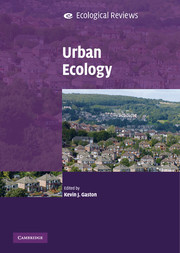Book contents
- Frontmatter
- Contents
- List of contributors
- Preface
- 1 Urban ecology
- 2 Urbanisation
- 3 Urban environments and ecosystem functions
- 4 Individual species and urbanisation
- 5 Species diversity and urbanisation: patterns, drivers and implications
- 6 Urbanisation and alien invasion
- 7 Interactions between people and nature in urban environments
- 8 Urban ecology and human social organisation
- 9 Urban ecology and human health and wellbeing
- 10 Bringing cities alive: the importance of urban green spaces for people and biodiversity
- 11 Integrating nature values in urban planning and design
- 12 Urban futures
- Index
- References
10 - Bringing cities alive: the importance of urban green spaces for people and biodiversity
Published online by Cambridge University Press: 05 June 2012
- Frontmatter
- Contents
- List of contributors
- Preface
- 1 Urban ecology
- 2 Urbanisation
- 3 Urban environments and ecosystem functions
- 4 Individual species and urbanisation
- 5 Species diversity and urbanisation: patterns, drivers and implications
- 6 Urbanisation and alien invasion
- 7 Interactions between people and nature in urban environments
- 8 Urban ecology and human social organisation
- 9 Urban ecology and human health and wellbeing
- 10 Bringing cities alive: the importance of urban green spaces for people and biodiversity
- 11 Integrating nature values in urban planning and design
- 12 Urban futures
- Index
- References
Summary
Introduction
A plethora of papers exist that trumpet the value of urban green spaces as providers of benefits to both people and wildlife (James et al. 2009). This body of work emphasises five means by which such spaces improve the urban environment: (i) shaping the character of the city and its neighbourhoods (Pauleit 2003); (ii) engendering a sense of place for city inhabitants (Frumkin 2003); (iii) providing a range of physical (Maas et al. 2006) and psychological (Hartig 2008) health benefits to people; (iv) supporting rich assemblages of wildlife, including many rare and endangered species (Gibson 1998; Mortberg & Wallentinus 2000); and (v) possessing important environmental functions that scale to provide a wide range of ecosystem services (Bolund & Hunhammar 1999; Elmqvist et al. 2004).
It is estimated that the number of urban areas with over a million people will grow by over 40% by 2015 (Crane & Kinzig 2005). To accommodate this rapidly increasing population and to reduce the deleterious impact of global sprawling cities (European Environment Agency 2006; Irwin & Bockstael 2007), in many countries regulatory bodies have created a range of policies on urban living, housing provision and city development that appear to be in conflict. On the one hand, policies exist espousing the utilisation of as much open space in cities as possible to meet construction targets for new-build housing (e.g. ODPM 2002a), while on the other hand different policy documents highlight the provision of green space for people and wildlife to enhance quality of life (e.g. EEA 2009).
- Type
- Chapter
- Information
- Urban Ecology , pp. 230 - 260Publisher: Cambridge University PressPrint publication year: 2010
References
- 24
- Cited by



